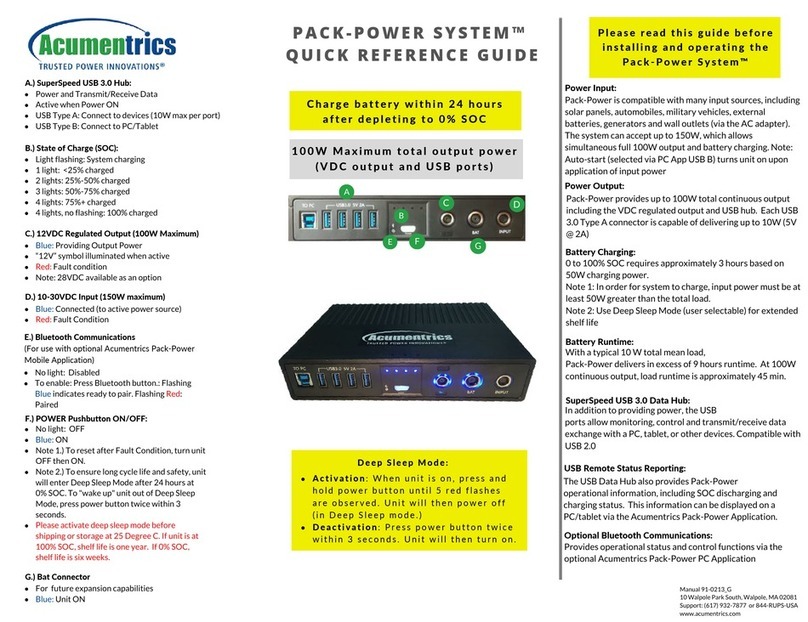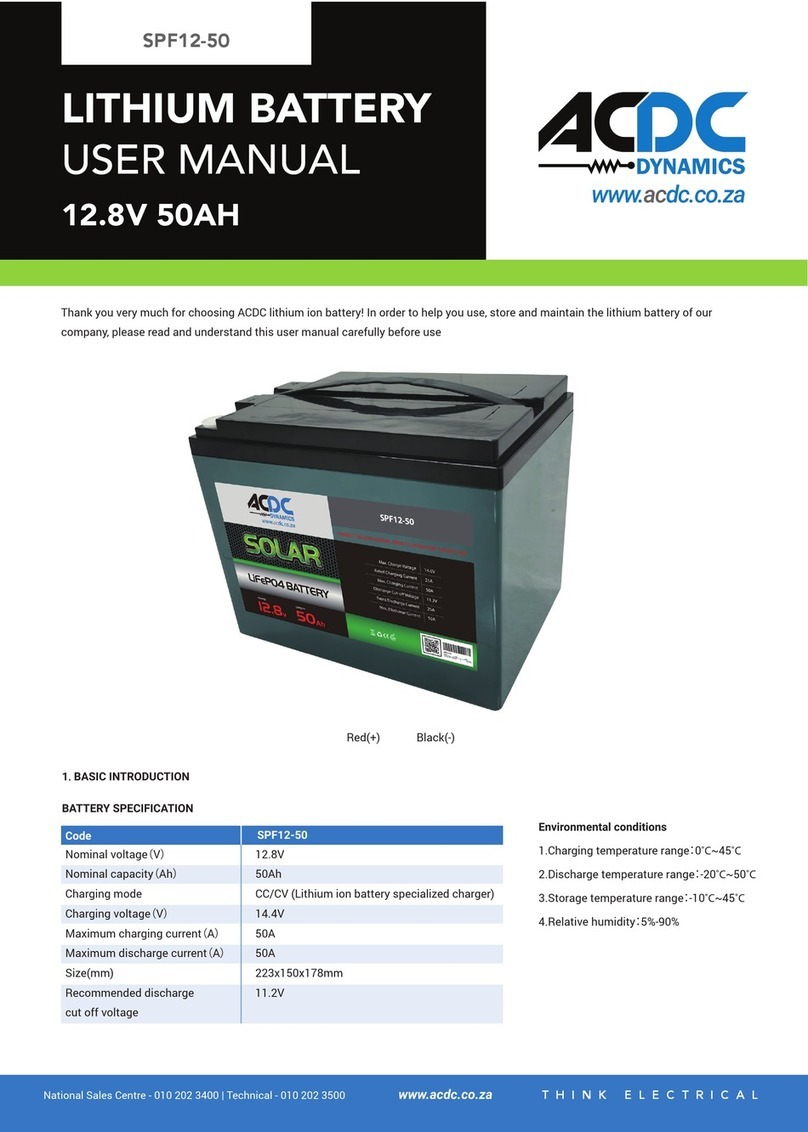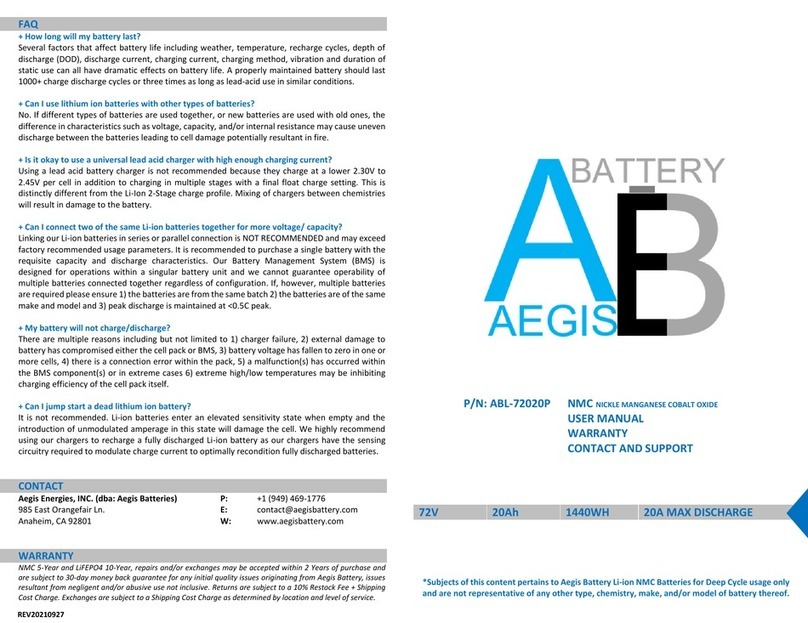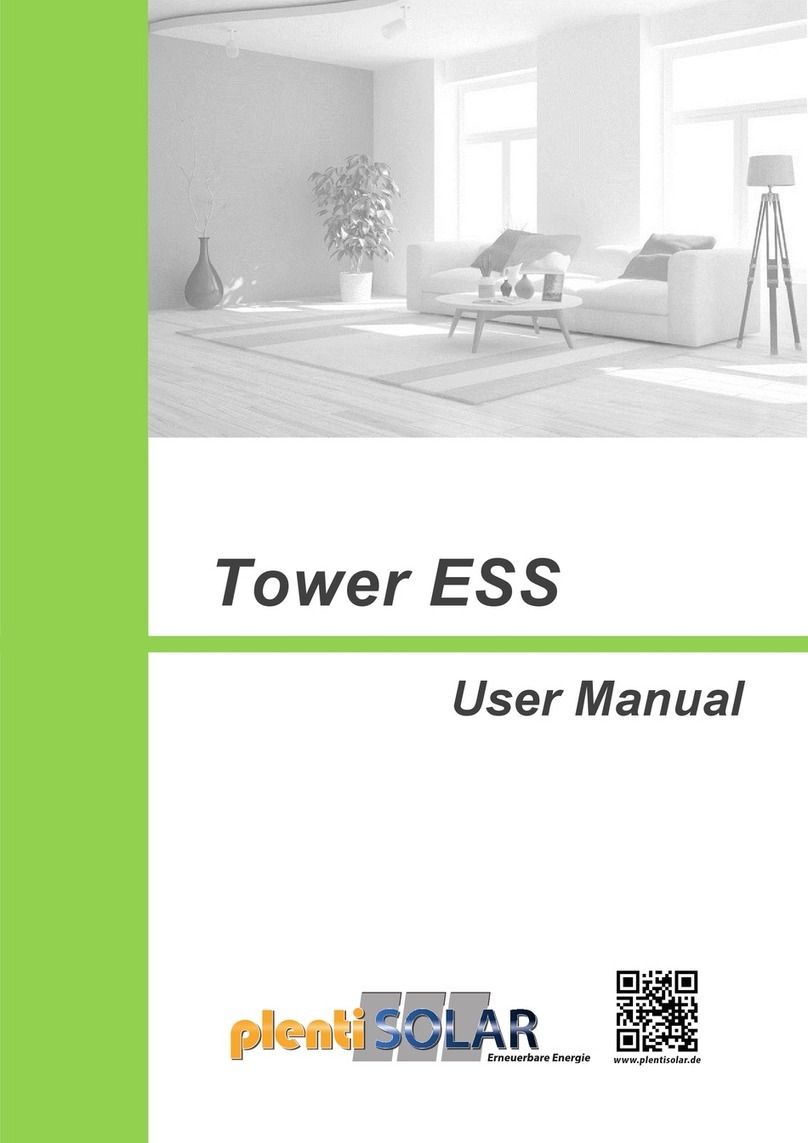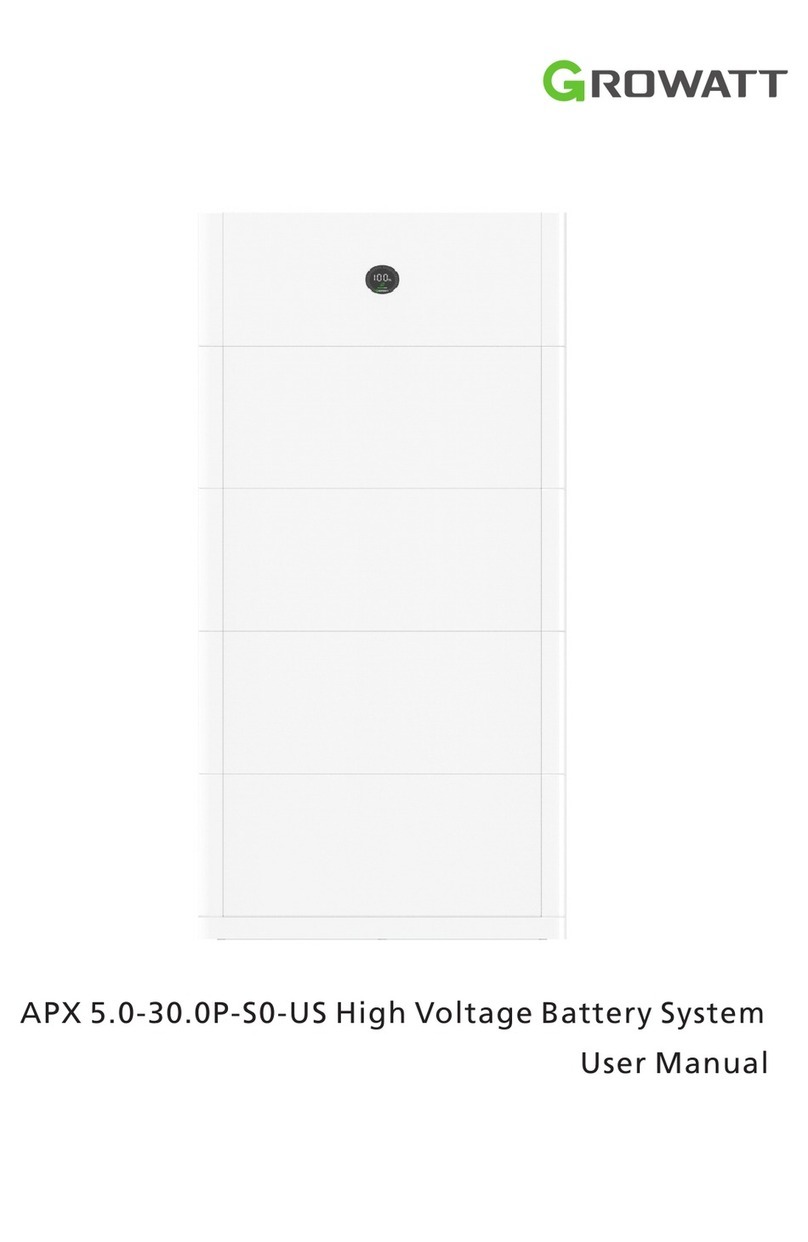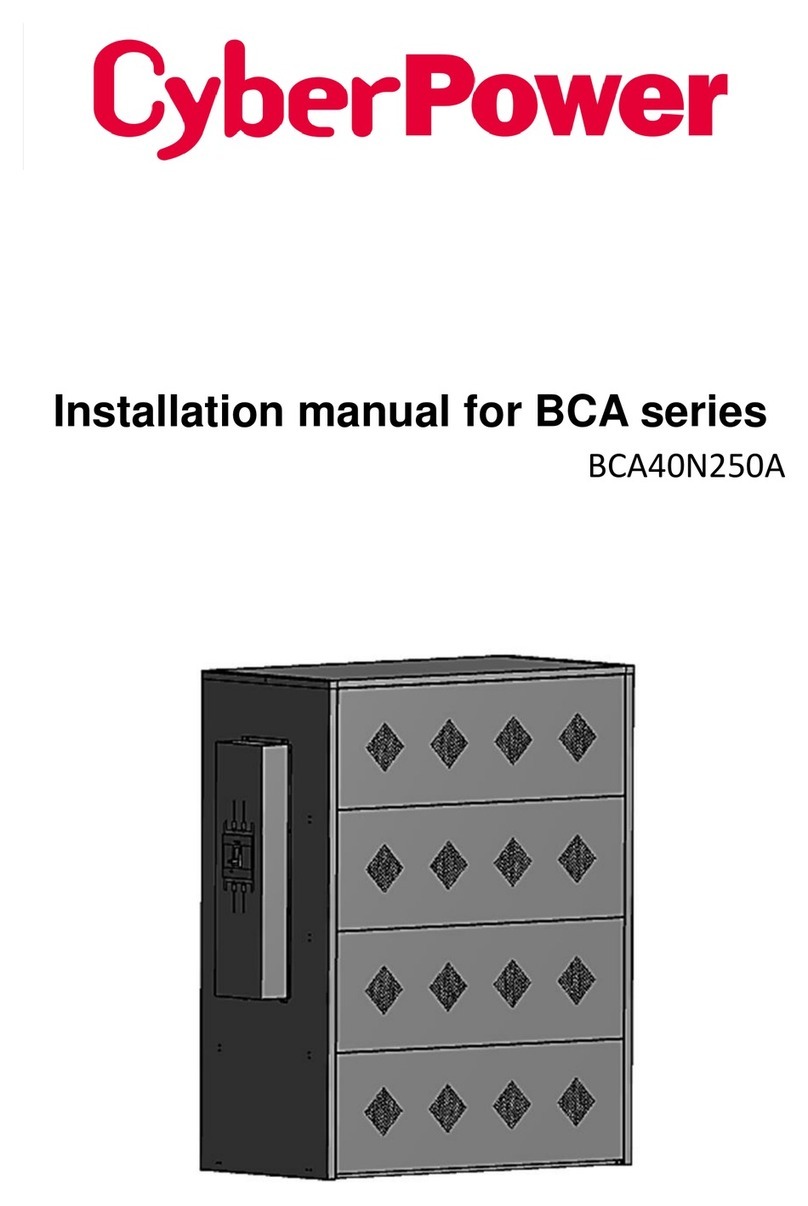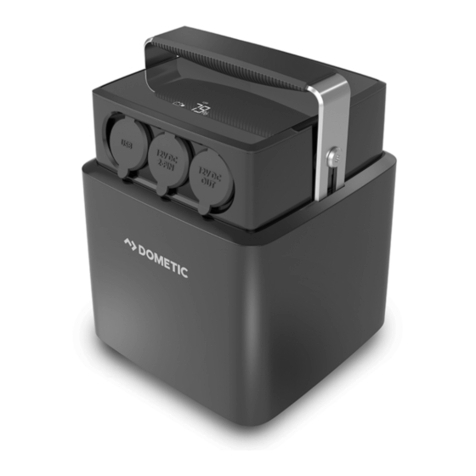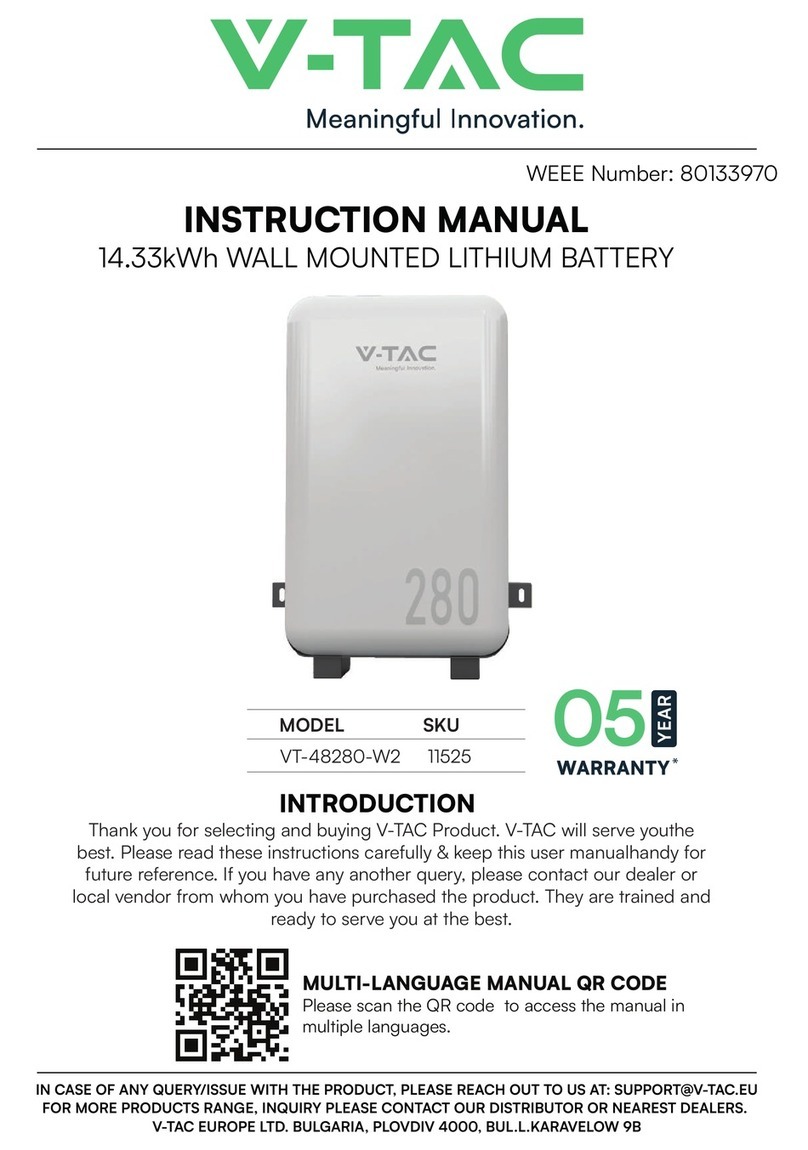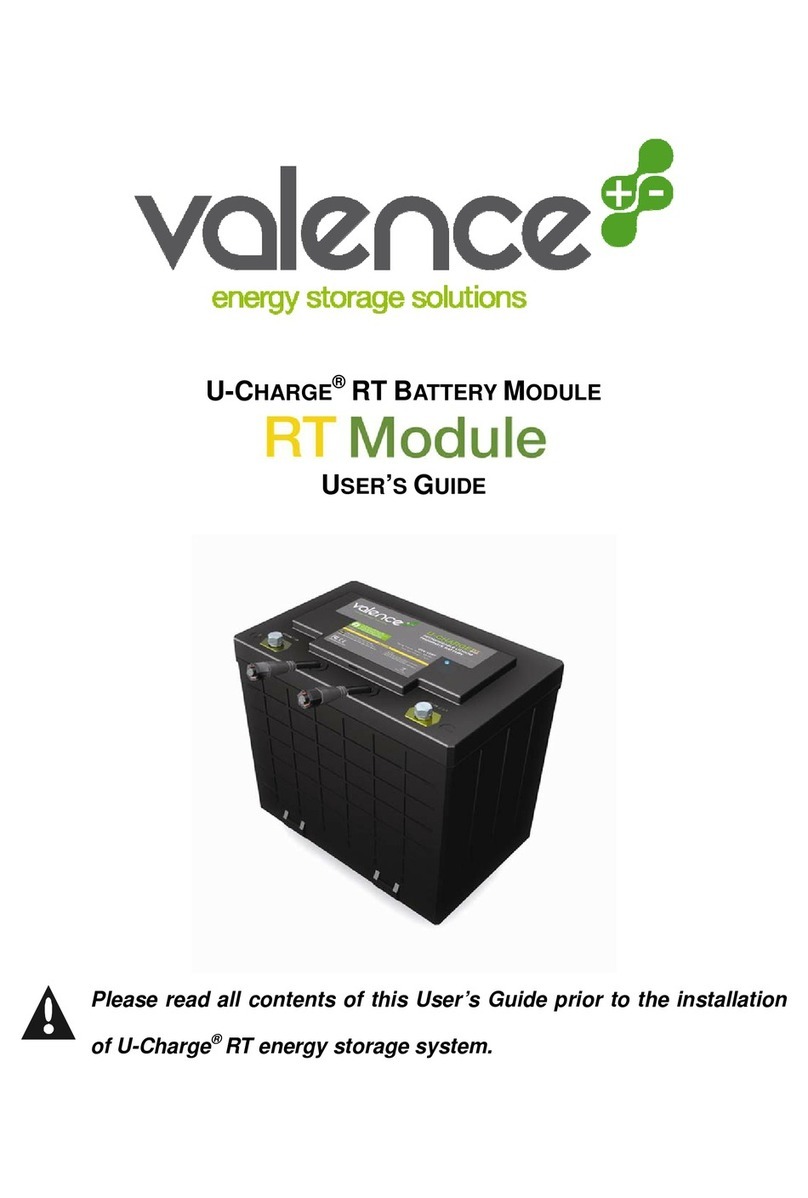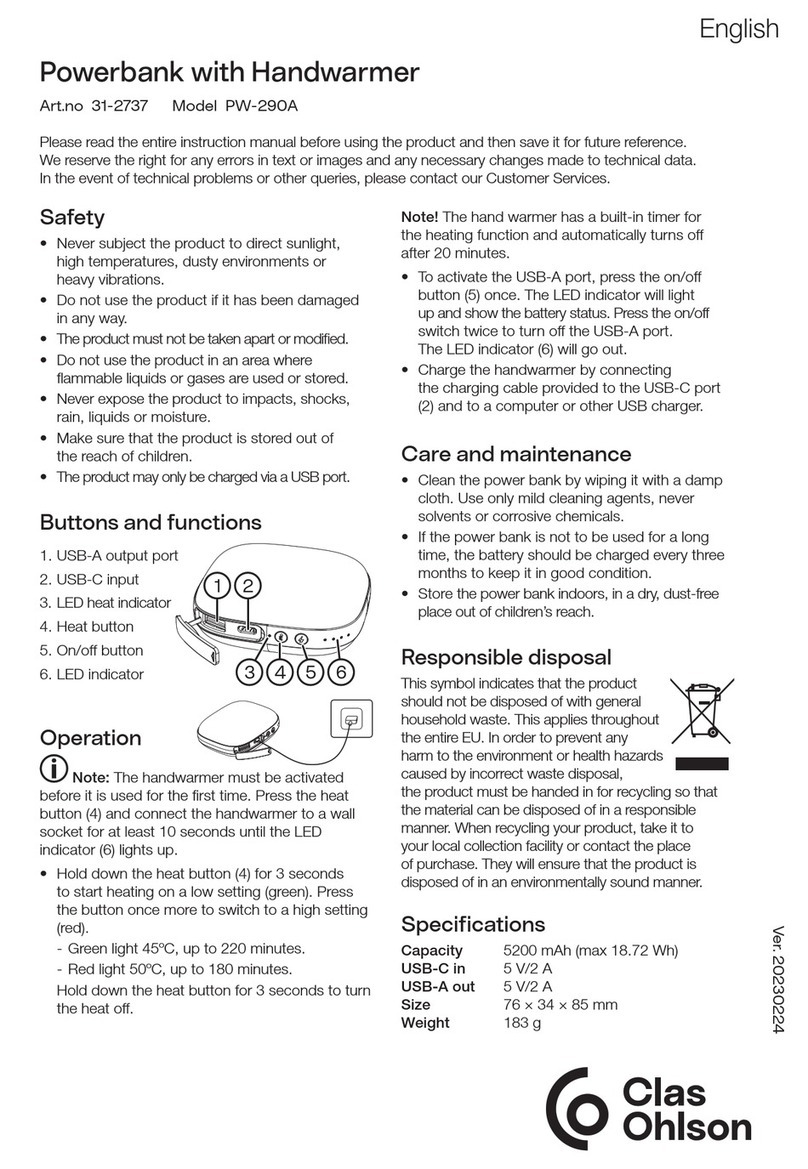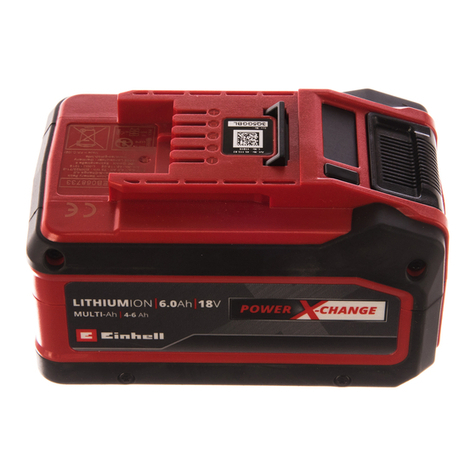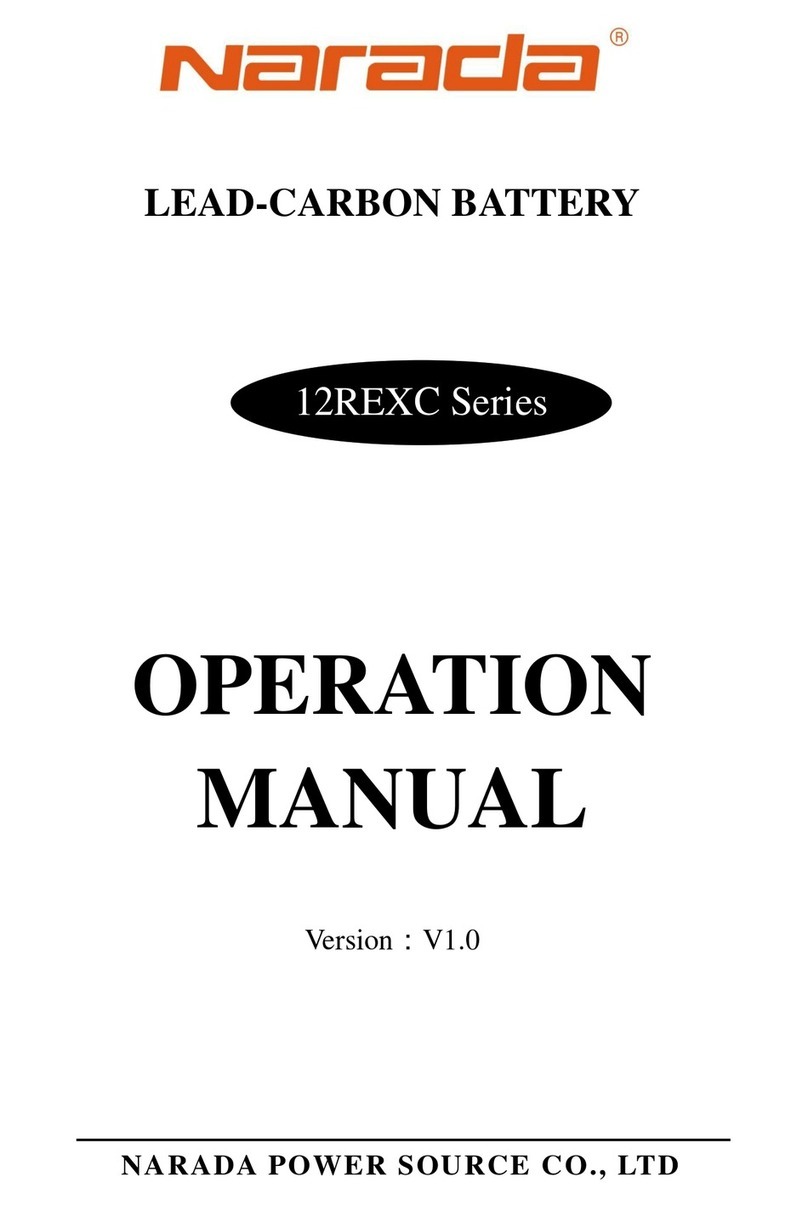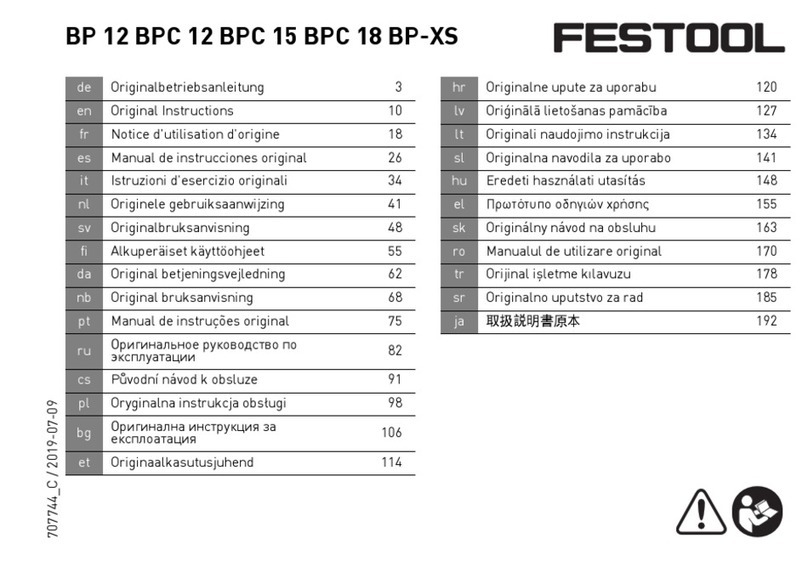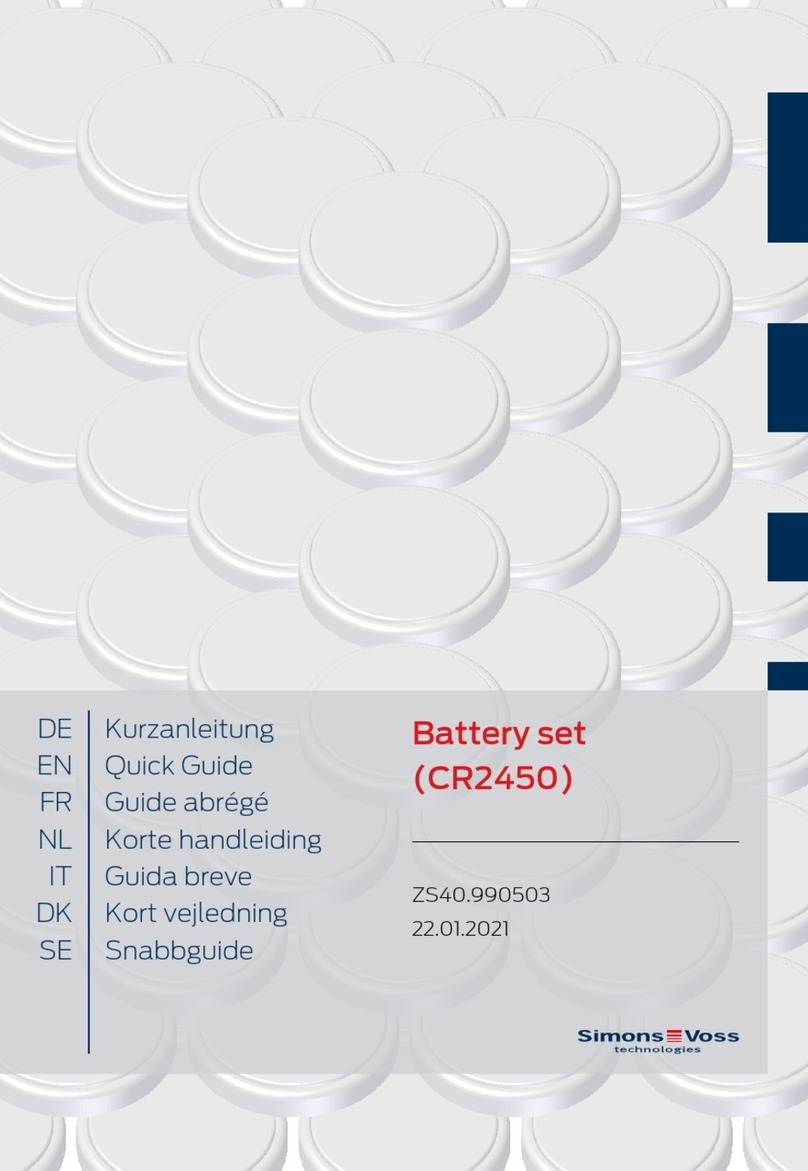Solar Stik 24VDC LI BOS 500-120 User manual

SETUP, OPERATION, AND MAINTENANCE GUIDE
FOR THE
24VDC LI BOS 500-120
P/N: 20-0205205
DISTRIBUTION STATEMENT A. Approved for public release; distribution is unlimited.
May 2023
SS20230605

Connections
Inputs
• (1) Universal AC (Schurter 6100-3300-32) (100-
230 VAC)
• (1) Solar (Cannon CB2-22-2SC)
Outputs • (2) 12 VDC (Amphenol MS3470W14-4S)
Inputs/
Outputs
• (1) ESM Expansion, 24 VDC, 100 A
• (1) ITT Cannon CB2-20-19SC
• (1) DATA port for battery rmware updates
Safety
Breaker(s)
• 30 A internal battery disconnect
• 30 A ESM input/output breaker
• 5 A AC input breaker
• 20 A solar input breaker
• 10 A 12 VDC output breaker
AC Charger Specifications (@77 °F/25 °C)
AC Input Frequency 50-60 Hz
AC Input Voltage 100-240 VAC
DC Output Voltage 29.0
Continuous Output Current 150-300 W/200-440 W (derived)
Environmental
Operating
Temperature -24 °F to 110 °F (-31 °C to 43 °C)
Storage
Temperature -28 °F to 145 °F (-33 °C to 63 °C)
Solar Charge Controller Specifications @ 77 °F (25 °C)
Maximum PV Voc 100 VDC
Maximum PV Isc 15 A
Nominal PV Power 440 W
Charge Control Method Maximum Power Point Tracking (MPPT)
Charging Voltage 29.0 VDC
Charging Current 15 A
Charging Stages Multi-stage adaptive
General
Nominal Operating Voltage 24 VDC
Battery Chemistry Lithium Ion
Storage Capacity 28 Ah
Energy Storage 672 Wh
Cycle Life* 3000 cycles (80% depth of discharge)
Battery Voltage Range 19.25 - 29.4 VDC
Internal cooling Forced cooling (1) air intake fan
User Interface E-Ink display with push button refresh
Case Pelican 1600
Transportation UN3481 Lithium-ion battery contained
in equipment
Warranty 1-year materials and workmanship
Weights and Dimensions (L x W x H)v
Weight 36.9 lb (16.7 kg)
Dimensions 21.51 x 16.54 x 7.99 in (54.61 x 41.99 x 20.29 cm)
*@ 77 °F (25 °C)
Specifications

Data*
SOLAR
INPUT
24 VDC ESM
ONLY 12 VDC
OUTPUT
x2
Connectors and Specifications
*Custom Cable Required
Connected to a Solar Array
Solar Cable

BOS Connectors and Ventilation
I = Air intake (vent has filter); E = Air exhaust (vent has no filter)
12 VDC
10 A
~120 W
Front
Left
Left
Front
Right
100–230 VAC, 50-60 Hz
5 A max
500-1200 W
33–100 VDC
20 A max
580 W max
Power Output
Power Input
Power Input/Output Ventilation
12 VDC Output: Pin A (+),
Pin B (-), Pin C (unused)DC
output voltage is equal to
DC bus voltage.
I
DATA: CAN data and
comms from internal battery.
Solar Stik use only.
Custom cable required.
E
Data
I

A. BOS setup and operation instructions.
B. Operational specications. Provides limits for AC and DC BOS circuits and internal battery specications.
C. Operational considerations.
D. QR Code that links to this document.
E. Internal battery status display reports voltage, current (A), state of charge, status (fault or OK).
F. Battery status DISPLAY REFRESH toggle switch
G. Breaker switches and circuit-activity LEDs.
H. Breaker switch for 12 VDC output.
I. The TECH port for use by Solar Stik use only. Contact Solar Stik for further information.
BOS 500-120 Faceplate
J
K
C
B A
D
E
F
GH
I

BOS 500-120-5205 Electrical Circuits
5
AC input
Solar input
DC bus circuit
Circuit breaker location
LED circuit activity indicator
1 3
Circuit Breakers
Numbers over breakers correspond to
numbered breaker locations on diagram
above.
2 4
30A
30A
Solar
Charge
Controller
480 W
*29.2 V
DC/DC
Converter 12 VDC
10 A Max
24VDC Li-ion (NMC)
Battery
48 Ah
672 Wh
SOLAR
INPUT
DC bus
2
3
Power
Supply
320 W
*29.2 VDC
120–230 VAC
INPUT
12 VDC
OUTPUT (x2)
4
5
1
5A
20A
10A
ESM
ONLY
5
*Programmed charging voltages

A. The DISPLAY REFRESH momentary toggle switch can be pressed and held to update the display during normal operation. During
normal operation, the display is updated automatically at intervals of three (3) minutes. The SOC is reported visually by a ve-
segment “fuel gauge”. Each segment represents 20% increments up to 100%.
B. Nominal voltage = 26.4 VDC; voltage @ 100% SOC ≈ 30.4 VDC; voltage @ 0% SOC ≈ 20.0 VDC.
C. The net current (A) with respect to the battery is positive when the BOS internal battery is charging and negative when
discharging.
D. If/when a battery fault occurs, the word “FAULT” appears in the upper right corner of the display. If the fault is unattended for
three (3) minutes, “FAULT” appears in large font, lling the screen. If the fault is not corrected within 60 minutes, the BOS will
enter storage mode even with the POWER switch in the ON position.
E. Batery Status report. OK=normal operating conditions, FAULT, is a prompt to nd additional information about the fault on the
second “page” of the Battery Status Display, which is accessed by toggling the Display Refresh switch twice.
Battery Status Display Home Screen
Battery net current + charging/- discharging
Battery voltage
SOC
Indicator.
5-segment
Status
OK/FAULT
C
B
A
E
D

Additional Battery Details
Toggle the DISPLAY REFRESH switch twice to view additional battery metrics.
CHC: Y/N: Charge FET on Yes / No, meaning yes the battery can be charged. No meaning the battery cannot be charged.
DSG: Y/N: Discharge FET on Yes / No, meaning yes the battery is discharged or No meaning the battery cannot be discharged.
Cyc: Number of complete charge / discharge cycles battery has experienced.
Term: CAN bus Termination is ON.
XX mA: Quiescent load on battery when not in use.
SOH = Internal battery state of health which is the remaining storage capacity as a percentage of the rated storage capacity when
battery was new.
SOC = Internal battery state of charge. 100% SOC is a fully charged battery.
Fault (not shown)-If a fault occurs, details about the fault will be reported on this screen.
Fault

Operation Instructions
1. Ensure all breakers are OFF before connecting anything to
BOS.
2. Connect solar array (if applicable) and load(s).
Note: Do not exceed ~120 W for both of the 12 VDC
output ports combined or the 10 A breaker switch may
trip.
3. Turn on INTERNAL BATTERY DISCONNECT breaker to
activate the BOS.
Note: INTERNAL BATTERY DISCONNECT breaker must
be ON for BOS to operate properly.
4. After the battery startup info has nished, toggle Battery
DISPLAY REFRESH switch to update Battery Status
Monitor.
5. Toggle ON 12 VDC OUTPUT breaker switch to support
loads. Green LED above breaker will illuminate when
circuit is powered.
BOS Connections and Activation BOS Charging and Discharging
Battery-only Run Times
The BOS internal battery stores 672 Wh of energy when fully
charged. Starting with a brand new battery, fully charged, the BOS
can support a 120 W load for ~5.6 hours, a 60 W load for
~11.2 hours. These times will decrease as the internal battery
ages and loses storage capacity. This is normal for all batteries.
Low-battery Cut Off (LVCO)
Power to loads will be disconnected by the internal battery when
SOC drops to 5%. Charging the internal battery back up to 10%
will allow power to loads to resume.
BOS Charging
Connect active universal AC and/or DC (solar) power source(s).
Toggle ON corresponding power input breakers.
120–240 VAC Charging: 320 W; minimum charge time from
empty is ~ 2.15 h.
Solar Charging: 440 W max; minimum charge time from empty
is ~ 1.5 h. Charging will begin when sufcient sunlight is present.
Solar power charging speed is a function of connected solar array
power output.
Energy Storage Expansion
Additional compatible batteries may be connected to the ESM
ONLY port. Contact Solar Stik Technical Support for information
regarding battery compatibility. Connecting incompatible batteries
can result in damage to equipment and may cause injury to
personnel.
• For information on expanding BOS 500 energy storage
capacity, contact Solar Stik.
• Do not connect lead-acid batteries to BOS.
• The BOS should be shaded from direct sun exposure and
sheltered from the elements as much as possible during
operation.
• Keep the case lid and connector covers closed when not
in use to prevent water and dust intrusion.
• Check the integrity of electrical connectors on a monthly
basis.
• Do not block air vents on case exterior. Clean or replace
air lters form optimum cooling.
Notice

The Battery Status Monitor will display the last status acquired before the POWER switch was turned OFF. However, battery voltage
will decrease during storage due to self-discharge. Toggle ON the POWER switch to update in-storage battery status.
In-storage BOS Internal Battery Status Information
MAINTENANCE CHARGING INSTRUCTIONS
Never store BOS in a discharged state! Charge BOS fully before placing in storage.
Never store a BOS with the BATTERY switch in the ON position.
Temperature-dependent Self-discharge
The self-discharge rate increases as storage temperature increases. If the BOS is stored at temperatures above 90 ºF (32 ºC), then
intervals between maintenance checks and / or charges should be reduced to three (3) months.
In-storage Battery Status Refresh: Voltage, SOC, and SOH
When the BOS BATTERY switch is OFF, the Battery Status Monitor will continue to report the last-recorded battery status; it does not
refresh automatically during storage. The Battery Status Monitor must be refreshed to report the current status while in storage.
1. Toggle ON BOS BATTERY DISCONNECT switch.
2. The Battery Status Monitor Screen will populate with up-to-date information. This will take ~ one (1) min. with the several startup
tests / results displayed before the Status Monitor is populated.
3. Check voltage and SOC on Home screen.
4. Toggle the REFRESH DISPLAY switch again to move to the Diagnostic Screen to check SOH.
This manual suits for next models
1
Table of contents
Other Solar Stik Batteries Pack manuals

Solar Stik
Solar Stik 24VDC LI EXPANDER PAK 1300 Installation instructions

Solar Stik
Solar Stik BOS 2000-120-5199 User manual

Solar Stik
Solar Stik 50-000335 User manual

Solar Stik
Solar Stik 24VDC Li ESM 2000 Installation instructions

Solar Stik
Solar Stik PRO-VERTER Installation instructions

Solar Stik
Solar Stik 24VDC POWER HUB 2400 Installation instructions

Solar Stik
Solar Stik Li Expander Pak 2400 User manual
